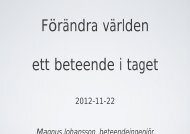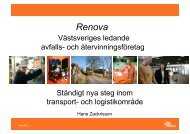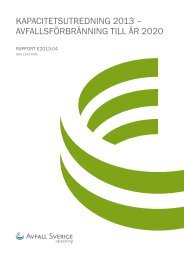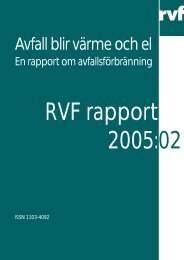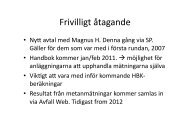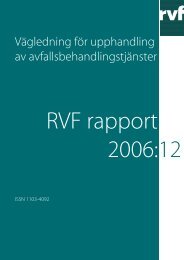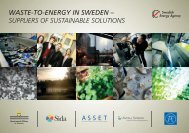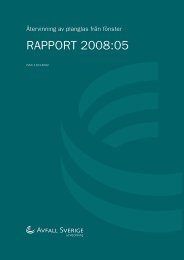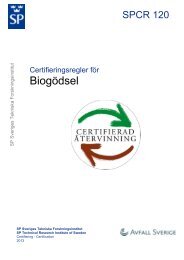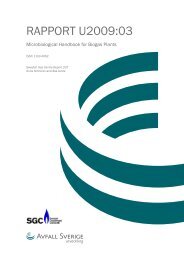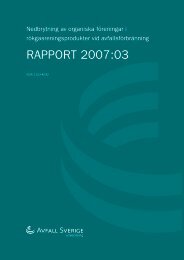2007:04 Hantering av förpackat livsmedelsavfall - Avfall Sverige
2007:04 Hantering av förpackat livsmedelsavfall - Avfall Sverige
2007:04 Hantering av förpackat livsmedelsavfall - Avfall Sverige
You also want an ePaper? Increase the reach of your titles
YUMPU automatically turns print PDFs into web optimized ePapers that Google loves.
DEWASTER ® - Sorting out the problems of mixed waste<br />
Appendix 1: Overview of the history and the objectives of the DEWASTER ® - system<br />
Background<br />
Beginning in the mid-1980s a number of Danish municipalities engaged in projects for the utilisation of<br />
the Organic Fraction of Municipal Solid Waste (OFMSW) based on source sorting, i.e. a separation of<br />
the organic (“green”, bio-degradable) and non-organic (“black”, non-bio-degradable) parts of domestic<br />
Municipal Solid Waste (MSW) at the individual households.<br />
Source sorting was normally accomplished by a two tier system of “green” and “black” garbage bags<br />
combined with particular collection schemes for certain types of waste, such as chemical waste,<br />
batteries, electronic equipment and recyclables).<br />
The aim of source sorting projects was to decrease the amount of (bio-degradable) waste for landfill or<br />
incineration and to utilise the OFMSW for heat and power production and for fertiliser. The utilisation<br />
of OFMSW was frequently accomplished by bringing the OFMSW to bio-gas plants for anaerobic codigestion<br />
with sewage sludge, animal slurry and/or industrial residues, thereby recovering a part of the<br />
energy potential of OFMSW in bio gas production. The waste remaining after co-digestion was utilised<br />
as fertiliser by spreading on farm land or by composting .<br />
The use of remaining organic matter as fertiliser entails stringent requirement that the input material<br />
for bio gas production, including OFMSW, is free of plastic, paper, metals and other items which are<br />
undesirable on farmland and adhere to threshold limits for he<strong>av</strong>y metals and various other pollutants.<br />
In Denmark, experience with the use of OFMSW in bio-gas production showed that the sorting quality<br />
from ordinary citizens was frequently insufficient, i.e. non-organic matter and organic matter with slow<br />
bio-degradability was put in the “green bags” through mistake or neglect and that , furthermore, the<br />
plastic and paper bags used for garbage collection themselves frequently left large amounts of plastic/paper<br />
which presented a problem both for bio-gas production as such and for the use of remaining<br />
organic matter as fertiliser.<br />
Aalborg 1999 – the first tests<br />
The idea for the DEWASTER system originates from a project at the bio gas plant at Vaarst-Fjellerad<br />
(VFB) in Jutland, Denmark.<br />
VFB is a facility based primarily on the processing of animal slurry. However, in 1998 VFB agreed with<br />
the municipality of Aalborg and number of surrounding municipalities in Jutland that trials should be<br />
carried out with co-digestion of other types of waste, including OFMSW.<br />
When operations started in 1998 it was soon discovered that the contents plastics in the OFMSW (in<br />
particular plastics from collection bags) was a serious, unanticipated obstacle to practical operations.<br />
In response to these problems the idea that plastics and other soft foreign matter could be separated<br />
from the organic part through a pressing process was devised. The idea was f<strong>av</strong>ourably received by<br />
advisors to the VFB project, and within a short period of time the first DEWASTER® screw press “prototype”<br />
was produced.<br />
The unit was operated by VFB/Aalborg municipality personnel on both OFMSW and CFW during trials<br />
at VFB in 1999 and 2000. Although the DEWASTER® screw press was at that time still a very untested<br />
product and the project management for the trials did not allow to make significant alterations to<br />
the unit, the results of the trials were considered very promising.<br />
page 2 of 9



